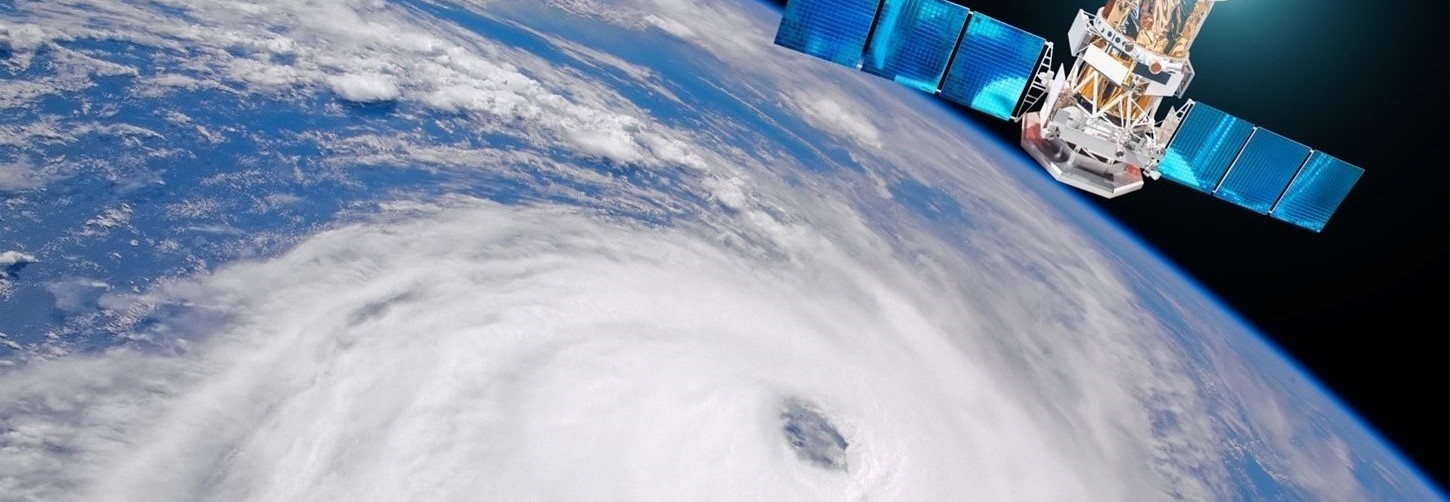Japan is a country prone to natural disasters due to its location in the Pacific Ring of Fire, where many tectonic plates meet. Here are some natural disasters that travelers might encounter when visiting Japan:
Typhoons
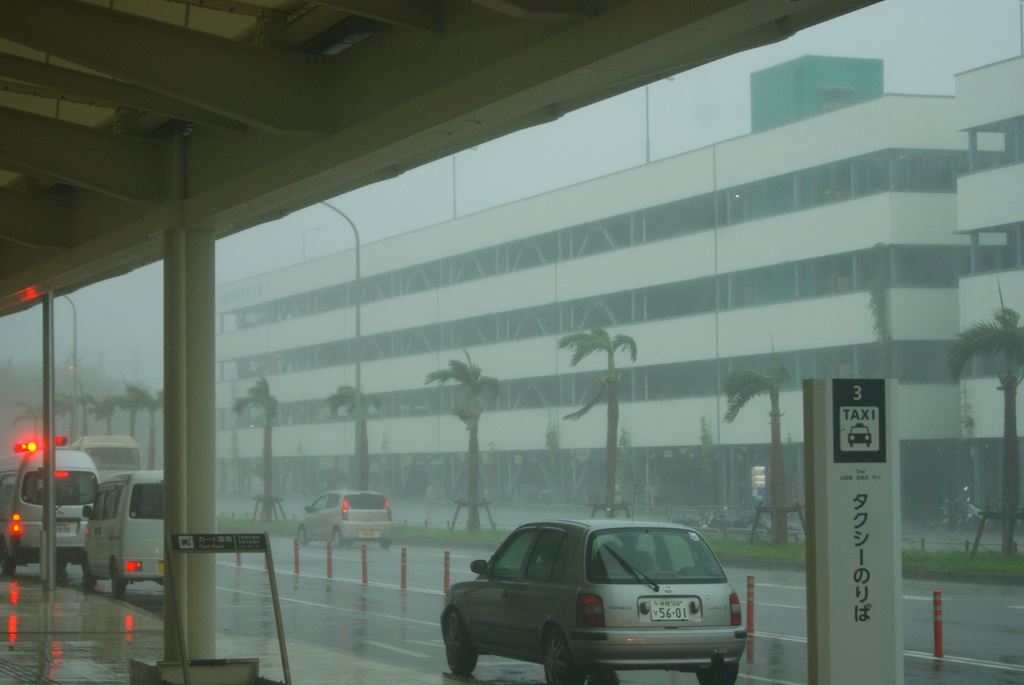
Typhoons follow courses closest to the Japanese archipelago from July to October
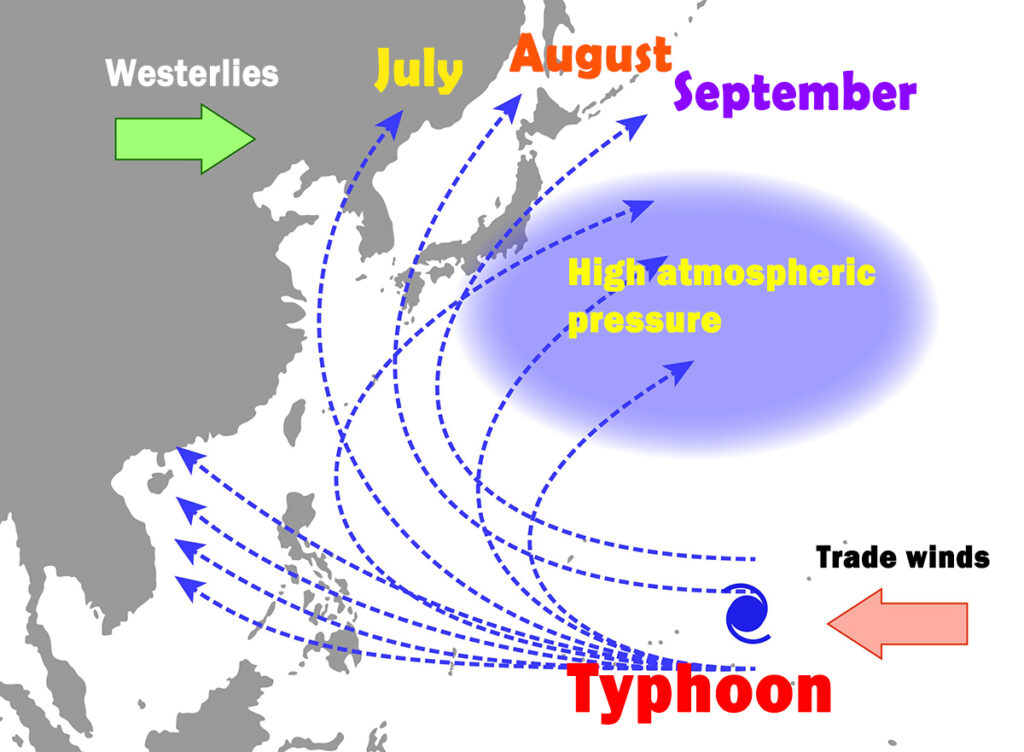
Typhoon track map. Typhoons follow courses closest to the Japanese archipelago from July to October.
Japan is frequently hit by typhoons, especially during the summer and fall months. Typhoons are tropical storms that can bring strong winds, heavy rain, and flooding. Some notable typhoons that have hit Japan in recent years include Typhoon Hagibis in 2019 and Typhoon Jebi in 2018.
Advice for travelers
- Stay informed: Keep up-to-date with the latest weather forecasts and evacuation advisories issued by local authorities.
- Avoid unnecessary travel: If a typhoon is expected, avoid traveling and stay indoors. Transportation systems may be disrupted, and some tourist attractions may be closed.
- Be prepared: Stock up on food, water, and other essentials before the typhoon hits.
- Follow evacuation orders: If local authorities issue an evacuation order, follow it immediately.
Read More >>
What is a typhoon?
A typhoon is a severe tropical storm that occurs in the western Pacific Ocean. It is characterized by strong winds that can reach up to 120 km/h or more, heavy rainfall, and storm surges that can cause floods and landslides.
When do typhoons come to Japan?
Typhoons typically occur in Japan from July to October, which is known as the typhoon season. During this period, warm and humid air from the Pacific Ocean converges with cold air from the Asian continent, creating a favorable environment for the formation of typhoons.
Why do typhoons come to Japan?
Japan is located in the western Pacific Ocean, which is a region that is prone to the formation of typhoons due to its warm waters and favorable atmospheric conditions. The typhoons that hit Japan are typically formed in the tropics and move towards the north, following the path of the warm ocean currents.
When typhoons come to Japan, what kind of damage do they cause?
Typhoons can cause significant damage to Japan’s infrastructure, including buildings, roads, and bridges. Heavy rainfall can cause floods and landslides, while strong winds can knock down trees, power lines, and other structures. In addition, storm surges can lead to coastal flooding, and in some cases, even cause damage to fishing boats and other vessels.
What will happen to airplanes, trains, and other forms of transportation when a typhoon approaches Japan?
When a typhoon approaches Japan, airlines may cancel or delay flights due to the strong winds and heavy rainfall. Similarly, trains may be delayed or suspended due to the risk of landslides and flooding. Other forms of transportation, such as buses and taxis, may also be affected, and travelers may need to make alternate arrangements.
What should travelers from overseas do before a typhoon hits Japan?
If you are traveling to Japan during the typhoon season, it is important to stay informed about the weather conditions and any travel advisories issued by the local authorities. You should also have a contingency plan in case your travel plans are disrupted, such as booking flexible tickets or travel insurance.
What should overseas travelers do when a typhoon is coming?
If a typhoon is approaching Japan, you should follow the instructions of the local authorities and stay informed about the latest weather updates. If you are staying in a hotel or other accommodation, you should also make sure that you have enough food, water, and other supplies in case you are unable to leave.
What should international travelers do after the typhoon has passed?
After the typhoon has passed, travelers should exercise caution when traveling in affected areas, as there may be debris and other hazards on the roads. It is also a good idea to check with your airline or transportation provider to confirm any changes to your travel plans. Finally, be aware that there may be delays or disruptions to public services, such as electricity and water supply, and plan accordingly.
Torrential downpour (Torrential rain)
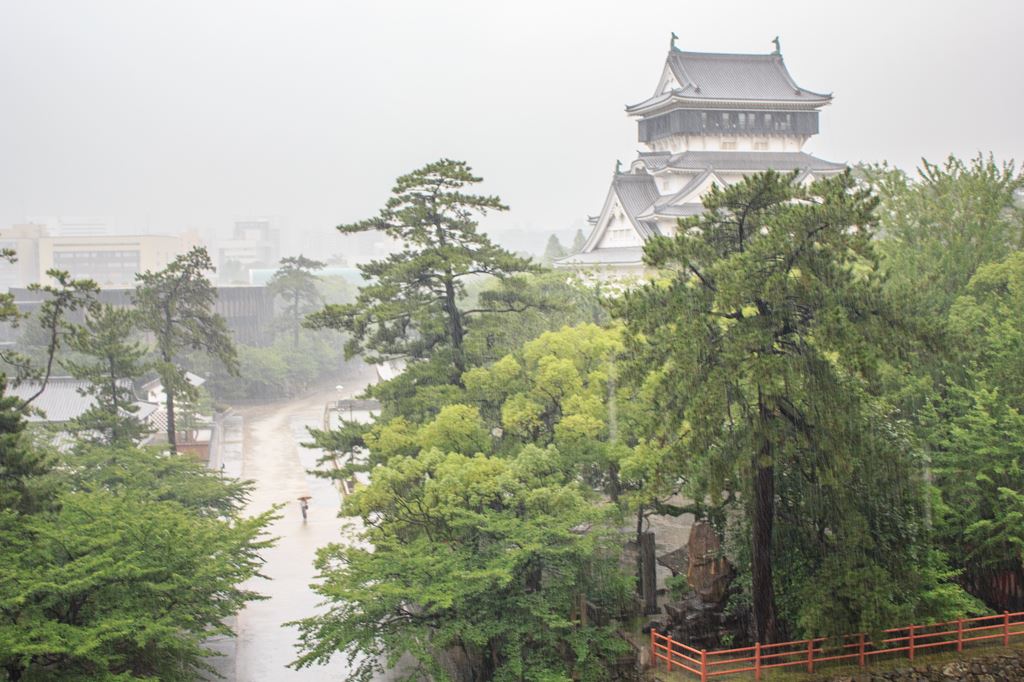
Japan experiences heavy rain throughout the year, but especially during the rainy season (usually June and July). This can lead to flooding and landslides, especially in mountainous areas. In 2021, parts of western Japan were hit by record-breaking rainfall that caused widespread flooding and landslides.
Advice for travelers
- Stay informed: Keep up-to-date with the latest weather forecasts and evacuation advisories issued by local authorities.
- Avoid areas at risk: If heavy rain is expected, avoid areas prone to flooding and landslides, such as mountainous regions.
- Follow evacuation orders: If local authorities issue an evacuation order, follow it immediately.
Read More >>
What is a torrential downpour?
A torrential downpour is a type of heavy rainfall that occurs over a short period of time. It is characterized by a large volume of rain falling in a short amount of time, which can cause flooding, landslides, and other types of damage.
When do torrential rains occur in Japan in particular?
Torrential rains in Japan typically occur from May to July, during the rainy season known as “Tsuyu.” During this period, warm and humid air from the Pacific Ocean collides with cooler air from the Asian continent, creating an environment that is conducive to heavy rainfall.
Which areas in Japan are particularly affected by torrential rains?
Western Japan, particularly the Kyushu region, is particularly prone to torrential rains and the damage they can cause. This is because the area is mountainous and has a high density of rivers, which can easily overflow during heavy rainfall.
What are the problems for travelers when torrential rains occur?
Torrential rains can cause travel disruptions, such as the cancellation or delay of flights, trains, and other forms of transportation. Roads and bridges may also be damaged or flooded, making travel by car or bus difficult or impossible. In addition, flooding and landslides can lead to power outages, food shortages, and other inconveniences.
What can we do to prepare for torrential rains?
Travelers should check weather reports and local news updates regularly to stay informed about the conditions. It is also a good idea to have a contingency plan in case travel plans are disrupted, such as booking flexible tickets or travel insurance. In addition, travelers should bring appropriate clothing and equipment, such as raincoats and umbrellas.
What to do when you encounter a torrential downpour?
If you encounter a torrential downpour, seek shelter in a safe place such as a building, train station, or convenience store. Avoid walking or driving through flooded areas, and do not attempt to cross bridges or rivers that have overflowed. Follow the instructions of local authorities, and stay informed about any evacuation orders or other emergency measures.
What to watch out for after a torrential downpour?
After a torrential downpour, travelers should exercise caution when traveling in affected areas, as there may be debris and other hazards on the roads. It is also important to stay informed about any ongoing weather or emergency situations, and to follow the instructions of local authorities. Additionally, travelers should be aware of the potential for disease and insect infestations in the aftermath of a flood or heavy rainfall.
Heavy snow
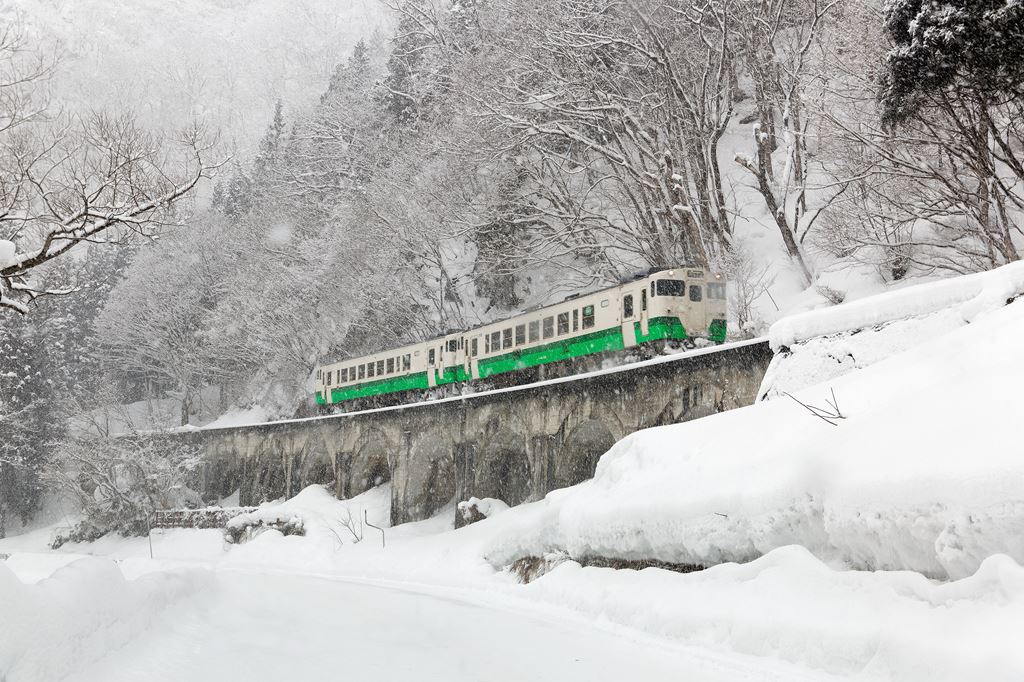
Japan’s northern regions, especially Hokkaido, experience heavy snowfall in the winter months. Snowstorms can disrupt transportation and cause power outages. In 2021, heavy snowfall caused train cancellations and road closures in Hokkaido.
Advice for travelers
- Check transportation schedules: If traveling during the winter months, check transportation schedules and be prepared for delays or cancellations.
- Dress appropriately: Wear warm clothing and footwear with good traction to avoid slipping on snow and ice.
- Be prepared: Stock up on food, water, and other essentials in case of power outages or other disruptions.
Read More >>
When does it snow in Japan?
Snow in Japan generally falls from December to February. The areas with the heaviest snowfall are Hokkaido and the Sea of Japan side of Honshu.
Which areas in Japan are particularly snowy?
Hokkaido, Niigata, Toyama, and other areas on the Sea of Japan side of Honshu are known for heavy snowfall. In these areas, it is not uncommon for snow to pile up several meters high, creating a beautiful winter landscape.
What can travelers enjoy in areas where it snows?
Travelers to snowy areas in Japan can enjoy a wide range of winter activities, including skiing, snowboarding, and snowshoeing. There are also many hot springs and traditional Japanese inns that offer a unique winter experience.
What kind of culture and ingenuity has developed in Japan’s heavy snowfall areas in order to survive in the heavy snowfall?
In heavy snowfall areas, residents have developed a variety of techniques and tools to deal with the snow. For example, many houses have steeply sloping roofs to prevent snow accumulation, and there are also traditional methods for removing snow from roofs and roads. Additionally, there are many festivals and events that celebrate the beauty and uniqueness of heavy snowfall, such as the Sapporo Snow Festival in Hokkaido.
What precautions should be taken to avoid heavy snowfall?
When traveling in heavy snowfall areas, it is important to be prepared for cold weather and potentially hazardous conditions. Travelers should bring warm clothing and appropriate footwear, and be aware of the potential for slips and falls on icy or snow-covered surfaces. It is also important to keep up to date with weather reports and follow the instructions of local authorities.
What to do in case of heavy snowfall?
If heavy snowfall occurs during your trip, it is important to stay informed about local conditions and any potential travel disruptions. Follow the instructions of local authorities, and seek shelter in a safe place if necessary. Travelers should also keep extra food, water, and warm clothing on hand in case of an emergency.
What should travelers do when airplanes, trains, and buses are stopped?
If transportation is stopped due to heavy snowfall, travelers should stay calm and follow the instructions of transportation staff. It may be necessary to find alternate forms of transportation or accommodation, so it is important to have a contingency plan in place. Travelers should also stay informed about any updates or changes to transportation schedules, and be prepared for potential delays or cancellations.
Major earthquakes / Tsunami
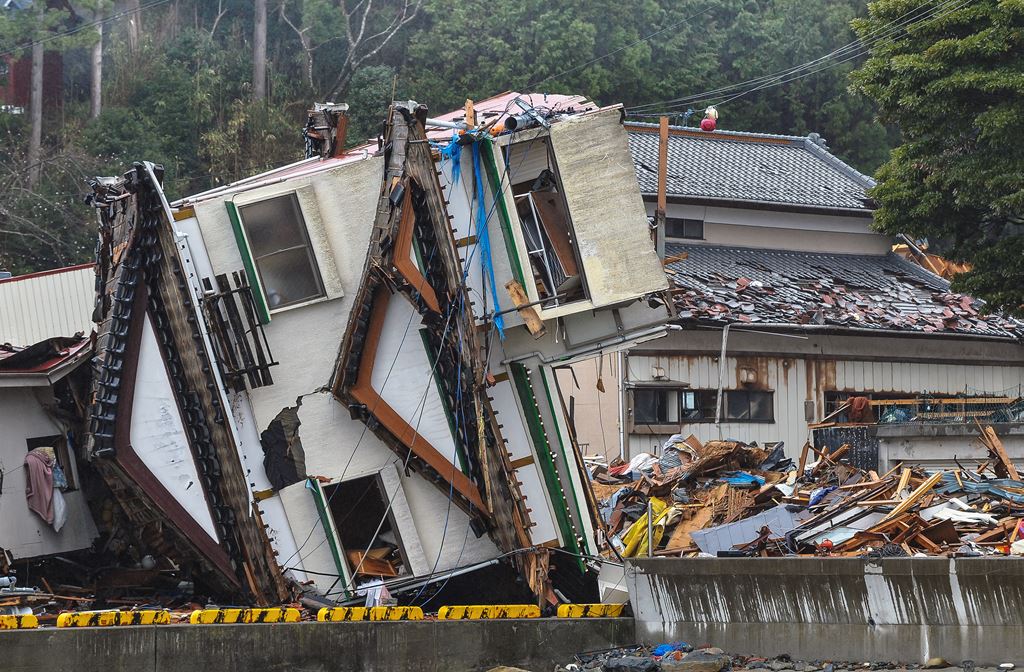
Japan is one of the most earthquake-prone countries in the world, and earthquakes can occur at any time. In 2011, a magnitude 9.0 earthquake struck off the coast of Japan, triggering a devastating tsunami that caused widespread damage and loss of life.
Advice for travelers
- Drop, cover, and hold on: If you feel an earthquake, drop to the ground, take cover under a sturdy piece of furniture, and hold on until the shaking stops.
- Follow evacuation orders: If local authorities issue an evacuation order, follow it immediately.
- Be prepared: Keep a disaster kit with essentials such as water, food, and first aid supplies.
Why Earthquakes Happen So Often in Japan
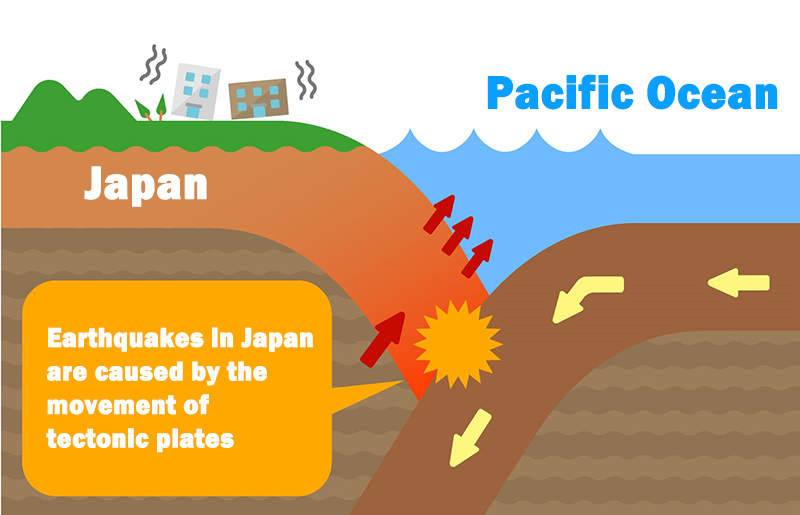
Japan is located in what is called the “Ring of Fire,” which is a region surrounding the Pacific Ocean where many tectonic plates meet and interact. Tectonic plates are large, solid pieces of Earth’s outer layer that move and shift over time.
At the boundary between two tectonic plates, there are often stresses and pressures building up as the plates push against each other. Eventually, the pressure becomes too great and the plates suddenly move in different directions, causing an earthquake.
In Japan, the Pacific Plate is colliding with the Eurasian Plate. This collision creates a subduction zone, which means that one plate is being pushed underneath the other. This causes a lot of pressure to build up, and when the pressure is released, it can cause a powerful earthquake.
The reason why Japan experiences so many earthquakes is because it is located at the intersection of several tectonic plates. Additionally, Japan is located on the eastern edge of the Eurasian Plate, which means that it is more vulnerable to earthquakes that originate from the Pacific Plate.
In summary, Japan experiences a lot of earthquakes because it is located in a region where several tectonic plates meet and interact. The collision of the Pacific Plate with the Eurasian Plate creates a lot of pressure, which can lead to powerful earthquakes.
Read More >>
What kind of major earthquakes occur in Japan?
Japan is prone to major earthquakes, including the Great East Japan Earthquake in 2011 and the Great Hanshin-Awaji Earthquake in 1995. These earthquakes had a devastating impact on the affected areas and caused significant loss of life and damage to infrastructure.
Why do earthquakes occur in Japan?
Japan is located on the Pacific Ring of Fire, a region of high volcanic and seismic activity. This means that earthquakes are relatively common in Japan due to the collision of tectonic plates.
What kind of damage is caused by a major earthquake?
A major earthquake can cause significant damage to buildings, roads, and other infrastructure, as well as loss of life and injury. The impact of an earthquake can also lead to disruptions to transportation and other essential services.
Do major earthquakes always cause tsunamis?
No, not all major earthquakes cause tsunamis. Tsunamis can be caused by earthquakes that occur under the sea or near the coast, but not all earthquakes result in a tsunami.
What should we do in the event of a tsunami?
If a tsunami warning is issued, it is important to move to higher ground immediately and follow instructions from local authorities. It is also important to avoid areas near the coast, rivers, and other bodies of water.
What precautions should travelers take in advance?
Travelers should be aware of the earthquake risk in Japan and take precautions in advance. This includes researching earthquake safety procedures, ensuring that emergency supplies are on hand, and registering with your home embassy in case of an emergency.
What should you do if a small earthquake occurs during your trip?
Most Japanese buildings are designed to be sturdy enough to withstand a major earthquake, so please calm down first. If a small earthquake occurs, remain calm and move away from windows or other objects that could fall. If you are indoors, drop to the ground, take cover under a sturdy piece of furniture, and hold on until the shaking stops.
What should I do in case of a major earthquake?
In case of a major earthquake, remain calm and follow instructions from local authorities. If you are indoors, drop to the ground, take cover under a sturdy piece of furniture, and hold on until the shaking stops. If you are outdoors, move to an open area away from buildings and other structures. After the shaking stops, check for injuries and damage and follow instructions from local authorities.
We support your itinerary planning!
Hotels & Tourist Routes
Click the button to get an overview of hotel information and popular tourist routes from all over Japan featured on our site.
We’ve included comprehensive details to aid in planning your trip, so please make use of it.
Comprehensive checklist before traveling to Japan
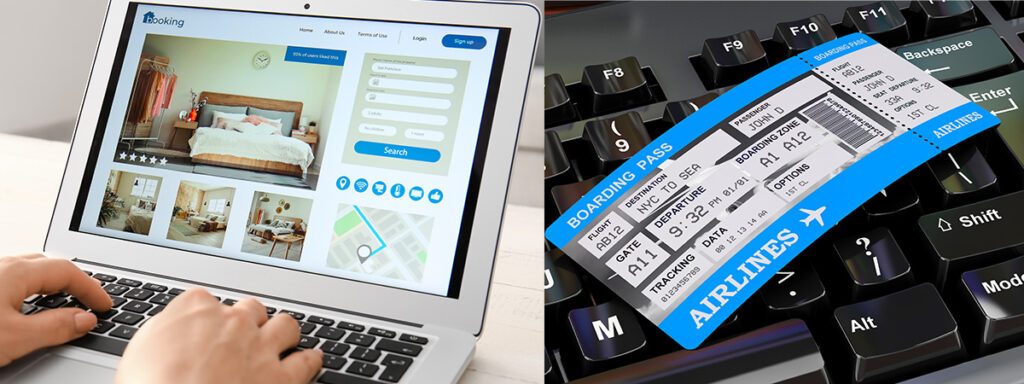

Book early before the hotels are fully booked
Japan offers a range of accommodations, from traditional ryokans to modern hotels. Popular platforms like Expedia and Agoda often have a wide selection, but also consider local sites like Rakuten Travel. In big cities, staying near a major train station like Tokyo's Shinjuku or Kyoto's Kyoto Station can save you a lot of commuting time. Remember that Japan's peak tourist seasons, such as cherry blossom season, can lead to booked-out accommodations, so reserve early.
>> Visit Agoda's official website
>> Visit Expedia's official website
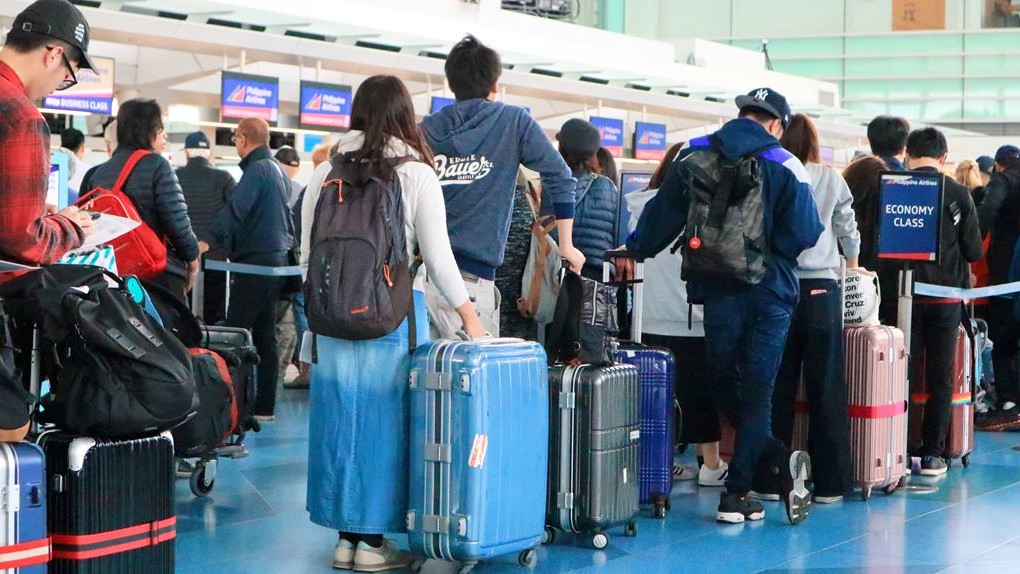
Compare and purchase flight tickets
When planning your trip to Japan, it's advisable to start by researching flights several months in advance. Airlines often release promotional fares, especially during off-peak seasons. Use comparison sites like Skyscanner or KAYAK to get a sense of the price range. Be flexible with your travel dates if possible; flying mid-week might be cheaper than on weekends.
>> Visit Skyscanner's official website
>> Visit KAYAK's official website
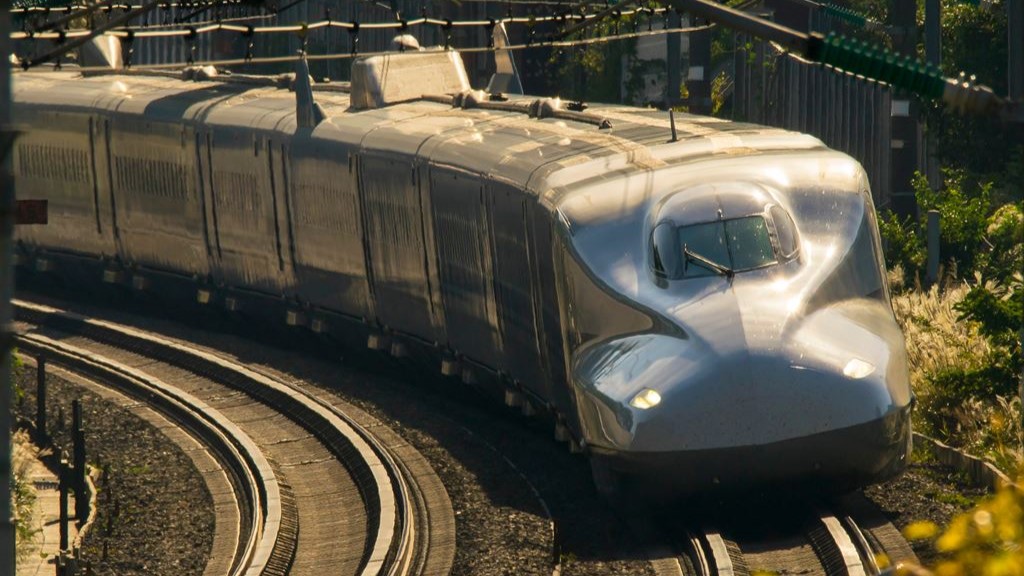
Purchase your Japan Rail Pass before departure
The Japan Rail (JR) Pass offers unlimited travel on JR trains, making it a cost-effective option for tourists. However, it's only available to foreign tourists and must be purchased *before* you arrive in Japan. Determine the areas you plan to visit; if you're traveling extensively, a nationwide pass is beneficial, but if you're only exploring a specific region, consider regional JR passes. Children under 12 get a discounted pass, so ensure you order the correct type for each family member.
>>Visit Japan Rail Pass's website
Check the weather at your destination on this site
Japanese weather varies significantly by season. In summer, it's hot and humid, so breathable clothes are essential. Winters, especially in the north, can be cold, requiring warm attire. If visiting during the rainy season (June to early July), pack a good umbrella and waterproof shoes. While Japan is generally casual, certain places like temples, shrines, or upscale restaurants may require modest and neat dressing.
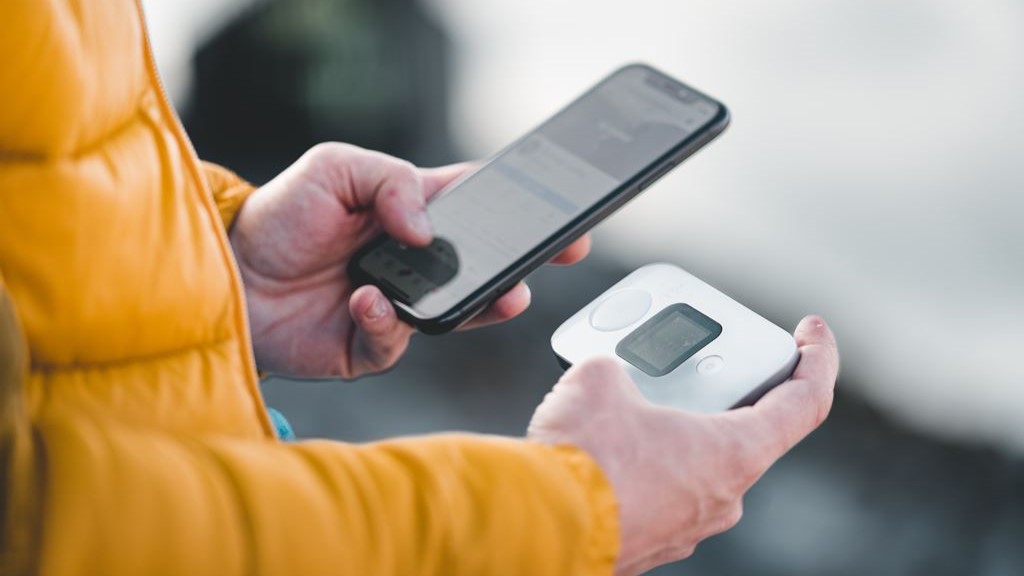
SIM card or pocket Wi-Fi is required
Beyond clothes, consider packing essentials like a universal power adapter (Japan uses Type A and B sockets), portable Wi-Fi or SIM card for internet access, and any necessary medications (with a copy of the prescription).
Which is better: a SIM card or pocket Wi-Fi?
When traveling in Japan, one essential to consider is securing internet access, especially given that many locations still don't offer free Wi-Fi. To ensure you can use your smartphone throughout your trip, you'll typically have three options: (1) a SIM card, (2) pocket Wi-Fi, or (3) the roaming service provided by your mobile company. Roaming services can be quite expensive, so we often recommend using a SIM card or pocket Wi-Fi. While SIM cards tend to be more affordable than pocket Wi-Fi, they can be trickier to set up. Pocket Wi-Fi, on the other hand, can be shared among several users, making it a favorable choice for families or groups.
▼SIM card
Advantages:
Relatively affordable.
Disadvantages:
Can be time-consuming to set up initially.
May have strict data limits.
▼Pocket Wi-Fi
Advantages:
Offers substantial data allowances.
A single device can be shared among multiple users.
Easily usable with PCs as well.
Disadvantages:
Typically more expensive.
Japan's representative services

Sakura Mobile's website
▼SIM card
>>Visit Sakura Mobile's official website
>>Visit mobal's official website
▼pocket Wi-Fi
>>Visit Sakura Mobile's official website
>>Visit NINJA WiFi's official website
>>Visit Wi-Fi RENTAL Store's official website
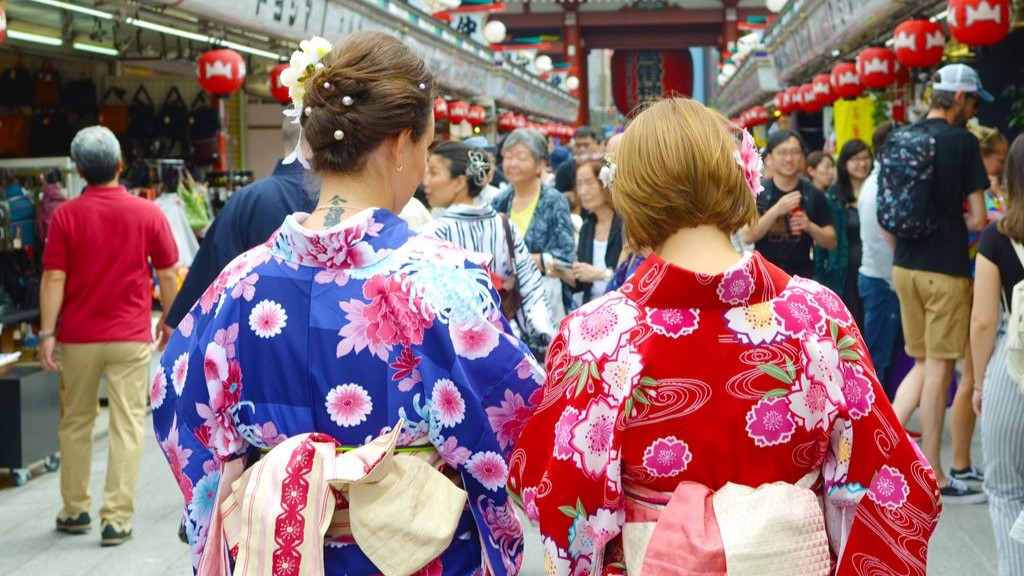
Pre-book your tour and have a great trip!
Local tours offer deep insights into Japan's culture and heritage. Websites like Viator or GetYourGuide offer a variety of tours, from traditional tea ceremonies to modern pop culture tours in Akihabara. Consider unique experiences like staying with monks on Mt. Koya or taking a cooking class to learn authentic Japanese dishes.
>>Visit Viator's official website
>>Visit GetYourGuide's official website

insurance concept, health, life and travel insurance
It is important to be prepared for emergencies
While Japan is a safe country, travel insurance is crucial for unforeseen events like health emergencies, travel disruptions, or lost baggage. Ensure your policy covers medical expenses in Japan, as healthcare, though excellent, can be expensive.
Here we introduce online travel insurance services that are popular worldwide.
World Nomads: An online travel insurance service widely endorsed by travelers worldwide. They offer plans that cover adventurous activities and high-risk sports.
>>Visit World Nomads' official website
AIG Travel Guard: An insurance service available to travelers all over the world. They offer a wide range of options, including cancellation protection and emergency medical insurance.
>>Visit AIG Travel Guard's official website
Organize your reservation information
Keep a digital and printed copy of your detailed itinerary, including hotel addresses, train schedules, and booked tours. Share this with a trusted family member or friend not traveling with you.











